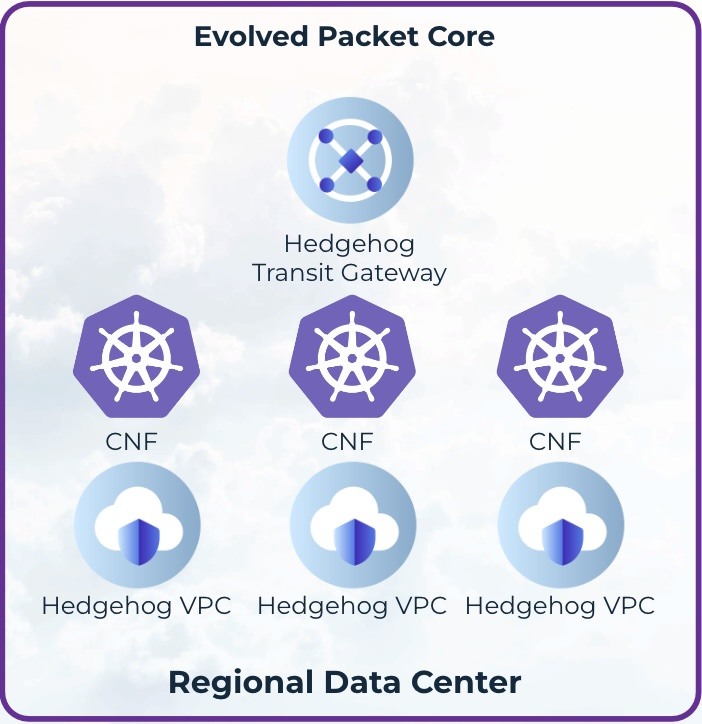Hedgehog is what happened to network automation
One of our customers recently sent us a repost of Bruce Davie's article "What happened to network automation?" It's indeed a reasonable question to...

Hedgehog is the Un-Vendor to telecom service providers who strive to be the Un-Carrier. We saw how the legacy network equipment vendors were treating their customers, so we started Hedgehog to break the mold. We still see legacy data center networking vendors desperately clinging to outdated practices, rigid contracts, and high fees while they rapidly lose IT market share to the Big 3. Telco workloads have been migrating to AWS, Azure and GCP where operations teams enjoy a convenient user experience, but they pay for it with stiff convenience fees and high interest-rate financing.
Hedgehog makes it possible for telecommunication service providers to take control of their core network costs with modern telco cloud infrastructure. Modern telco cloud in turn unlocks opportunities to innovate with AI for better spectrum utilization and new customer experiences. Our telco cloud customers network like hyper-scalers with a convenient, simple, cloud-native user experience at a fraction of the cost of the Big 3 or legacy network equipment vendors.
Telecommunication service providers operate a lot of data center infrastructure, otherwise known as "telco cloud." Telcos build cloud infrastructure to run a variety of workloads critical to delivering 5G and other network services. These workloads include operational support systems (OSS), business support systems (BSS), and core network functions. The problem with telco cloud infrastructure is that it normally isn't cloud-native. Most telcos continue to operate data centers with legacy, proprietary data center technologies that don't scale or offer the same user experience as public cloud services offered by providers like AWS, Azure or Google Cloud Platform (The Big 3).
Things are starting to change, though. With the advent of 5G, most mobile service providers migrated away from buying network function hardware appliances from traditional vendors like Nokia and Ericsson. They started adopting the ETSI standards for Network Functions Virtualization (NFV). This telecom trend coincided with early concepts of Software Defined Networking (SDN) and required virtualized infrastructure from vendors like VMWare. Management and orchestration (MANO) of these Virtualized Network Functions (VNFs) proved difficult in VMWare environments. Meanwhile cloud-native computing rapidly evolved with the use of containers on The Big 3, and Kubernetes quickly became the de-facto technology for cloud-native workload orchestration. This caused NFV to evolve into Cloud-native Network Functions (CNFs).
Kubernetes orchestration of cloud native workloads works incredibly well in containerized environments at the Big 3. Unfortunately, CNFs don't really work at all in legacy telco data center environments. Proprietary, vertically integrated infrastructure from traditional telco vendors doesn't provide the same cloud-native user experience as the Big 3. Ironically, vendor lock-in inhibits many telcos from executing their strategies to cost-effectively compete for customers by breaking carrier lock-in. This problem only gets worse with the rapid change that AI is bringing to all markets, starting with AI-RAN in the telecom industry.
The problem is HUGE. Juniper Research estimates that telcos will invest over $200 billion over the next 4 years in cloud infrastructure to run their core networks. This cloud infrastructure is distributed. OSS/BSS, Policy Control Function (PCF), Network Repository Function (NRF) and core network CNFs may run in regional data centers, while CNFs like User Plane Functions (UPF), Access and Mobility Management Function (AMF), Session Management Function (SMF), and Content Delivery Network (CDN) caches run in metro edge data centers for lower latency and better user experience.

Many telcos run their CNFs on public cloud infrastructure from the The Big 3. In the race to launch 5G, most telcos didn't have time to modernize their data center infrastructure for cloud-native. Instead they asked their traditional vendors to give them CNFs as a service. They swapped hardware appliances for SaaS, but the vertically integrated traditional vendor lock-in persisted with very expensive CNFs as a service. Smart service providers are now seeing the opportunity to optimize cost and innovate further by taking control of their cloud-native infrastructure. This is a must-do in competitive markets for saturated smartphone services where price matters to consumers.
CNFs from multiple vendors require multi-tenant isolation. A Nokia CNF needs to run in a separate cloud network than an Ericsson CNF or an Amdocs OSS/BSS. The Big 3 solve multi-tenant isolation with Virtual Private Cloud services. VPCs in multiple availability zones can communicate with each other using Transit Gateway services. The Big 3 have proven that simple, flat network architectures combined with powerful software automation can deliver unprecedented operational efficiency and service agility at hyper-scale. The challenge has been that replicating this approach required building custom networking solutions from the ground up – until now.

Today's telcos need more than just another SDN solution. They need cloud-native infrastructure that delivers:
The network must mirror the operational model of hyperscalers, with a simple, flat Layer 3 underlay that supports on-demand creation of Virtual Private Clouds (VPCs) and network services. This architecture eliminates the complexity of traditional telco networking while enabling cloud-native automation at scale.
Breaking free from vendor lock-in means more than just supporting multiple hardware vendors. It requires an open architecture that gives providers choice in both their underlay equipment and overlay services, with the flexibility to mix and match solutions based on their needs.
Operations teams need the same seamless experience that public cloud providers offer, with API-driven automation, infrastructure-as-code practices, and instant provisioning of network services – all without sacrificing the control and cost efficiency of running their own infrastructure. Your existing cloud operations team should continue to use DevOps best practices - writing declarative infrastructure as code, managing it with source code control in Git, and incorporating common cloud-native tools like Terraform and Ansible with observability from Grafana, Prometheus and Loki.

Hedgehog is transforming telco cloud by bringing hyperscaler-grade networking to every provider. Our approach breaks the mold of traditional networking vendors with an Open Network Fabric that delivers:
Unlike complex legacy solutions, Hedgehog's unified software appliance provides a single point of control for both underlay and overlay networking. Our cloud-native API and familiar VPC abstractions make it possible for any DevOps team to deploy and operate network services with the same ease they experience in public clouds.

We're breaking vendor lock-in with an open architecture that supports your choice of whitebox switching from providers like Celestica, Dell, Edgecore, or Supermicro. Our Gateway services ensure seamless integration between new and existing infrastructure, letting you modernize at your own pace while extracting maximum value from existing investments.
.png?width=2801&height=2001&name=cost-compare%20(1).png)
By combining hyperscaler-inspired architecture with open networking principles, Hedgehog delivers cloud-native networking at a fraction of the cost of both legacy vendors and public cloud providers. Our solution eliminates expensive integration requirements and complex licensing models, replacing them with a simple, unified platform that scales efficiently with your needs.

One of our customers recently sent us a repost of Bruce Davie's article "What happened to network automation?" It's indeed a reasonable question to...

Most investors associate NVIDIA with GPUs and recognize GPUs as the key ingredient for AI cloud infrastructure. But that’s only part of the AI...

I’m pleased to announce that Hedgehog Open Network Fabric powered by SONiC is now available for download at https://githedgehog.com. We developed...